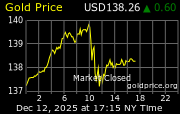Investors are once again jittery about the region’s prospects for solving the ongoing debt problems
 Along with rest of the commodities, gold have been hard hit by renewed concerns over the Eurozone, as evidenced by soaring borrowing costs in Spain. Investors are once again jittery about the region’s prospects for solving the ongoing debt problems, as Spain moves closer to elections that many say will see a change in government.
Along with rest of the commodities, gold have been hard hit by renewed concerns over the Eurozone, as evidenced by soaring borrowing costs in Spain. Investors are once again jittery about the region’s prospects for solving the ongoing debt problems, as Spain moves closer to elections that many say will see a change in government.Our main concern for commodities is the potential for liquidity squeeze in Eurozone money markets. To this end our barometer of Eurozone monetary tightness (the Euribor/OIS 3-month spread) has pushed significantly higher over the last few days. We caution that all commodities will suffer should money markets dry up, even gold and silver.
Despite concerns over the Eurozone, investment demand seems lacklustre as investors seem to prefer the relative safety of the dollar. This is something we have seen happen often over the past few weeks, but eventually investor demand does again return, so we could see some strength on the Monday open (barring any major developments on the Eurozone front).
Our Standard Bank Gold Physical Flow Index (GPFI) remains in negative territory, indicating the relatively weak physical demand. However, the same thing happened a few weeks ago and physical demand soon rebounded. We are confident that this will happen again as buyers in Asia (more from China, Thailand and Indonesia than India) return to the market at the current
relatively low prices. According to previous seasonal patterns, Indian buying should return around January next year.
Gold support is at $1,703 and $1,678. Resistance is $1,759 and $1,792.














0 comments:
Post a Comment